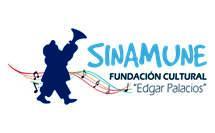
LA MÚSICA, EL LENGUAJE QUE INTEGRA A TODOS EN LA DIVERSIDAD
MUSIC, THE LANGUAGE THAT INTEGRATES ALL IN DIVERSITY
Sinamune in Quito, Ecuador provides musical education, training, therapy, and participation in an orchestra for children and young adults having special needs.
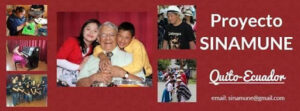
Vision
Sinamune, a permanent project of the cultural Foundation Edgar Palacio, seeks to work in favor of people with disabilities through an artistic program that allow its users to be socially integrated and recognized through the development of adaptive skills in an environment of creativity, effectivity, competence, cultural activity, and constant growth and innovation. The Sinamune Project seeks to integrate people with disabilities among themselves and with the community, encouraging and developing them to be more independent.
Sinamune has brought art closer to disability and has given voice to the excluded…a clear, beautiful, and powerful voice. The face of people with disabilities is seen in its complex artistic and human dimension, breaking discriminatory barriers and opening space in the world of art and creativity.
Comments of Maestro Edgar Palacios, founder of Sinamune
“My name is Edgar Palacios, and I’ve been a musician since I can remember. The experience of disability in my own family convinced me of the need for persons with disabilities to enjoy music, one of the most noble and sublime experiences of man.
In Ecuador there are no existing initiatives that view music as integral to special education; nor is there provision of testing and training of people having deficiencies in intellectual, auditory, visual, or multiple disabilities. Also, therapeutic processes for children and youth with disabilities have not applied music alternatives in their education.
Few initiatives in the musical field have been planned as alternative work and inclusion of the special needs population into the productive sectors of the country. Rather there are isolated initiatives that have failed to make a change in the experiential universe of children and young people with disabilities in Ecuador.”
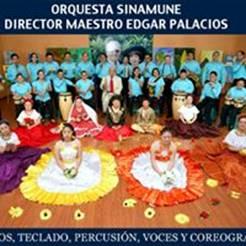

History:
The Cultural Foundation “Edgar Palacios” was created in the year 1992, to support educational artistic development in Ecuador. In January 1993, with the support of the Ministry of Education and Culture of Ecuador, the Cultural Foundation’s founder, Maestro Edgar Palacios*, created the project National System of Music for Special Children. NA. MU. N.E., in order to provide therapy and musical training, where possible, for children and young people having special needs: physical, visual, intellectual deficiency and multi-disabilities.
Objectives also included: integrate people with disabilities among themselves and with the community; form instrumentalists who integrate music groups; provide tools that enable the labor inclusion of musicians in any musical artistic space with skills they need.
In order to provide musical training, there was need to overcome the limitations of students that might include: structuring the body schema, coordination, laterality, muscle strength, attention and memory, behavior, low self-esteem, lack of personality development and dependence in activities of daily living. Students with visual disabilities shared some of these limitations, adding difficulties in communication, behavior problems, fear of the movement, and lack of challenges. Moreover, students with physical disabilities evidenced problems of dissociation of movements, difficulty in mobility and need for adequate physical spaces.
*Palacios is a talented musician who has more than 150 original compositions to his credit as well as numerous CD’s
Highlights:
1995: the Special Orchestra SINAMUNE in Ecuador is created, under the direction of Maestro Edgar Palacios
1996: production of first recording entitled “Music without Barriers”.
1998: sound production Orchestra Musicians Ecuador Special entitled Ladders to the Sun was performed.
2002: published the album “Faith planting, harvest of love,” implemented the Instrumental Musician Training Project for children and young people with disabilities, in the city and province of Loja
2003: published the album Party in ECUADOR, selling 5,000 copies and national tour, visiting cities from Tulcan, Ibarra, Latacunga, Ambato, Riobamba, Cuenca, Portoviejo, Manta, Bahia de Caraquez.
2004: the Orchestra made its first international tour, the tour Party Iberoamericana in Spain and Italy, making presentations before the Holy Father Juan Pablo II (+) and distinguished authorities from both countries. The tour included a disc Ibero-American Festival and the video documentary Building Dreams of Love.
2006: 3rd international tour, SINAMUNE PERU 2006, performing successful presentations in the cities of Lima, Trujillo, Piura and Cajamarca.
2007 at the International Conference on Culture and Development. Master Edgar Palacios, presented the paper Music, the Language that Integrates all Diversity.
2010: organization and participation in Festival Artistic Special Hearts in the Middle of the World.
2011: national tour “SINAMUNE Sings to the World, participated with the National Ballet of Ecuador. Organization and participation II Festival Artistic Special Hearts in the Middle of the World.
2012: organized concerts TROPICALISSIMO SINAMUNE – ECUATORIANISIMO SINAMUNE in commemoration of the 20 years of existence with participation of renowned national artists, such as Paco Godoy, Astrid Achi, Jorge Saade, Ecuadorian Ballet of camera, Hnos. Nuñez, Chimera Group among others.
2014: launched latest album SINAMUNE: Salsa Cumbia and Rumba, offering a show at the national theatre of Ecuador with the National Ballet of Ecuador.
Participation in the 1st Festival of art and disability in Ipiales, Colombia.
2016: international tour to Colombia and Panama, participating in the International Festival of culture in Boyacá. A group of presentations is done in Panama City for International Disability Day.
2017: participated in Latin American Meeting of Disability Education, Culture and Social Responsibility in the city of Lima, Peru, national tour with the German orchestra Brenz Band.
Audiences served
Currently SINAMUNE has 28 students from Ecuador, children and young people, who all have physical and/or mental challenges. These may include physical disabilities such as blindness, deafness, or motor and mental disabilities such as Down Syndrome. The program serves people, who may start at the age of 12 years. There is no age limit for ending participation. Programs are formed based on individual needs.
In addition, teachers and volunteers of many nationalities work under the direction of Maestro Palacio with assistance of Maestro Pablo Mora.
Many national and international audiences have been given the opportunity to experience the beautiful music of the orchestra.
Main Activities
Sinamune teaches many varied skills to disabled persons through the use of music and participation in an orchestra. The Centre teaches how to play different instruments. When the students have developed some skills they become part of the orchestra. The orchestra practices and has presentations every day, and it gives concerts in an average of one per month. Within the tasks that are planned in each program there are excursions, exhibitions, concerts, presentations, interviews etc.
The SINAMUNE project focus on the arts such as: Instrumental practice, Orchestra, Assembly groups, Fine arts., Song and chorus, Dance, Modeling, Drill Dance.The institution also works with the artistic skills of the students, teaching them painting, dancing , and handicrafts among others. Students with fewer difficulties are trained in working inclusion.
In addition to these activities, taking into account that students who attend SINAMUNE can start at 12 years of age, they receive a reinforcement of academic tasks (math, language, natural environment) according to their skills. The areas of computing, swimming and sports are added according to individual needs and interests.
The program is both individually based as well as community based. It provides opportunities to work as a team. It fosters responsibility and persistence.
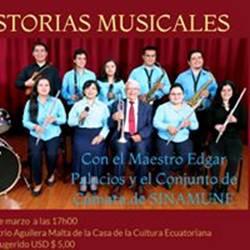
Skills are developed through additional activities:
Occupational art: Students \ perform pre-work routines that allow them to perform in productive alternatives to artistic activities.
Academics: Students have basic academic skills that are reinforced, allowing them to develop in artistic spaces of medium complexity.
Therapeutic artistic: Artistic activities are used as a therapeutic means in the habilitation and conditioning of skills to be developed in other educational programs of greater demand.
Orchestra workshop: Students who have some kind of artistic ability in the areas of dance and music are guided by professionals who instruct and develop the work to participate in a musical group. They work in different behavioral, performance and artistic participation areas, minimizing their limitations.
Daily care: Basic daily life skills are developed taking into account the individual needs and abilities, for good family and social interaction.
Home assistance is aimed at those people who due to a situation of calamity or other major issue cannot attend the educational institution, for whom an individualized work programs are established with families to work in their respective homes guided by a professional.
This special educational academic project focused on music offers the possibility of future professional opportunity for students and a pathway for work.
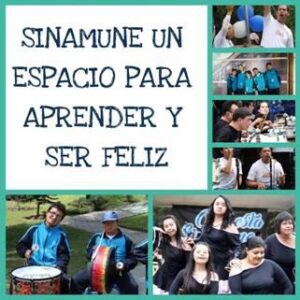
Performances
https://www.youtube.com/watch?v=TpM6qSGg–0
https://www.youtube.com/watch?v=tFs5yYTWKtc
https://www.youtube.com/watch?v=kR3xs09yJug
Other links
https://vimeo.com/199574145
https://www.facebook.com/echoinni/videos/t.100001474503418/10206659318460363/?type=2 & video source = user_video_tab
Successful impact
During these 25 years of the Sinamune Project, hundreds of students have been forming artistically and experiencing new alternatives of performance, which has enabled them to be applauded, appreciated and recognized for their skills despite their limitations.
Some of the musicians have taken part in other musical groups or developed solo careers.
The country’s authorities and organizations have been able to recognize the success of the project, especially its perseverance in working with persons with disabilities, enabling them to visualize their existence and social contributions.
There are many stories of success. Here is one example.
Katy and the Turkish March
Katy, a young woman with total blindness and sequelae of infantile cerebral palsy (which as a result caused hemiplegia that added to his visual impairment) joined the Yes project. NA.MU.N.E. in 1993.
When her mother took Katy to SI. NA. MU. N.E., she was fighting for the right to her daughter to live fully, despite the views of some doctors had recommended that she not insist on teach Katy to walk> They stated, “Katy did not need to learn how to move alone, because she could not see.”
For eight years, Katy began to study the electronic keyboard and gradually gained independence and muscle strength in her fingers. Her musical ear and innate talent enabled her to quickly learn the melodies that the Orchestra ran. However, the aftermath of infantile Cerebral Palsy had provoked a hemiplegia on the left side of her body, and her left hand had great difficulties to achieve a correct position that would allow her to run the keyboard with both hands.
The difficulties of coordination, driving force of independence movements, synchronism in the execution of the keyboard, which one day made Katy a pianist, made the orchestra persist in her skill development; we were not prepared to lose the battle. We started with a program of therapy and rehabilitation of its sequelae of cerebral palsy, exercising movement and independence of the fingers of her left hand on the piano of wood, (in which there was greater chance of these exercises yielding the desired fruits), and after few months Katy was able to interpret the prelude No 1 by Juan Sebastián Bach. Given her progress, tenacity and effort, we decided that Katy perform in its orchestral arrangement of “March to the Turkish” by Mozart, to be incorporated it in the Repertoire of the Orchestra. . Katy suffered the pains of his rehabilitation, but managed her left hand to learn to move on the keyboard and to be strong enough to produce sounds and music.
Today Katy today is 33 years old and has a professional life as a teacher of music. Although she has not been involved with the Orchestra since 2005, the most valuable thing we could offer was her experience with the Orchestra: a life.
Recommendations for replication and/or adaptation
-
- The dynamics of group participation has provided many successes.
- Creation of programs is based on the educational needs of the students. At a beginning of each admission there should be an initial evaluation of skills of each applicant and of the needs of his/her family.
- Participation: Having the right people who can intervene in the different areas that arise, either therapeutic or artistic.
- Instruction: A minimum of 10 hours test per week. The pieces of music to be taught must be from the simplest ones that help rhythmic development. Students should start in this training to then improve and be educated musically.
- Community involvement is an important component of Sinamune’s mission. According to Maestro Palacios, “The participation of the community and the families of students are very important for music education. Community awareness helps build the capabilities of our students, monitoring and enforcing the tasks that occur in the classroom and elsewhere.”
- Support of government and other contributors such as non-profit institutions is recommended. While the community continues to support the school, unfortunately the government of Ecuador does not, withdrawing financial support in 2012. Sinamune has the challenge of becoming self-supporting. All of the orchestra’s students are on scholarship, at an annual cost of $5,000 per student, compared to $3,000 for many other kinds of programs.
Sustainability: To have the orchestra become self-sustaining through entrepreneurial activities, the school created a boutique to sell clothing, crafts, and other merchandise to help finance the institution. The boutique was officially opened in April of this year, and, not only does it support the organization financially, it also helps students learn valuable skills, such as textile production, organizing workshops, generating support from the community, and learning about business and money management.
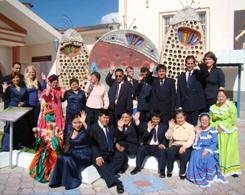
Future Plans
Maestro Palacios has other dreams for the school, as well. For example, he hopes someday to expand programming to include evening and weekend classes in other artistic areas, such as dancing, visual arts, mime, and handcrafts—and he plans to support this project and more through the sale of CDs and DVDs featuring performances by the orchestra. Grand Circle Foundation, one of its supporters, hopes to help fund the recording and production of these materials so that Maestro Palacios can begin raising funds nationally and internationally. The maestro hopes to expand the program geographically, as well. “Sinamune is an example throughout our region,” he says. “The dissemination and replication of this project could benefit thousands of people with disabilities.”
Above all, however, to Maestro Palacios, it’s about the music. His greatest joy comes from seeing the students interpret the repertoire of the orchestra. “The joy is in the group,” he says. “That’s what music is about—expressing feelings. It allows our students to demonstrate that disability is not a limitation but an opportunity to show that the human being can get everything despite their limitations.”
The Orchestra plans to offer the show Sinamune Sings in Quito in December.
Contact information
Web: https://voluntariosecuador.wixsite.com/sinamune
EMail: sinamune@gmail.com, kleberacurio@gmail.com
Address: Fundacion Cultural Edgar Palacios
Av. Diego Vásquez de Cepeda N77-530 y Antonio Núñez,
Pichincha, Quito, 170102, Ecuador
Phones:
+59322476413
+59322476374
+59322483983
+593996603639 whatsapp
+593996603640 whatsapp
Newspaper article
Orquesta Sinamune shows that disability is not a barrier
El Universo, Culture, Monday, July 30, 2012
 The Orchestra of the National System of Music for Special Children is directed by teacher Edgar Palacios
The Orchestra of the National System of Music for Special Children is directed by teacher Edgar Palacios
People not only have the ability to cultivate their intellect, but their most human part. They are like trees that grow little by little. The music droplets of the Sinamune Orchestra (National System of Music for Special Children) made many plants grow last Saturday. On the platform of the MAAC, hundreds of outdoor spectators discovering what the event was about, they met the 32 members of the orchestra, including musicians and dancers.
The melodies of the Ecuadorian repertoire had a special highlight thanks to them. They heard Farrista Quito or La Morista, Angel de Luz or Nuca llacta and Chulla Quito. Under the direction of maestro Édgar Palacios on the trumpet, those men and women showed that they were special, not because of their disabilities, but because of all the effort that has involved playing the instruments, singing and captivating, as they did that night.
They did not keep the formalities or the seriousness that can be seen in the big presentations. If they wanted to laugh, they did it; if something came out not so well, his good spirits remained. In the last section of the recital, something happened just outside of what was planned: in its interpretation of the Creole Romance of the girl from Guayaquil, the sound failed, but that did not stop the Sinamune musicians from continuing, nonchalantly. This earned them the applause and cheers of the attendees, who then decided to buy the recordings of Sinamune, available that night. They were audio-visual compilations of the presentations of the orchestra that has also performed outside the country, including for Pope John Paul II.
His technique was not perfect, but they were disciplined and coordinated. Some, when they were near the end of a melody, looked at their teacher full of happiness, with a clear admiration in their eyes.
In the evening, not only they were protagonists. The soprano Astrid Achi also appeared on the scene, who accompanied by the pianist Panchito Godoy performed El avocado, Júrame and other melodies that kept the audience expectant. There was also the violinist Jorge Saade and the Ecuadorian guitarist based in Germany Julio Almeida.
Caty Vinueza, one of the founders of the group, is blind from birth. He came to the world prematurely and his eyes never developed. Graduated in Initial Education, she affirms that she prepares and works hard because she wants to give back to life a part of how much she has given to her.
At the end of the day several of the boys and girls of the orchestra approached the audience to invite them to dance after having given them choreography to the rhythm of sanjuanito.
In December, it will be 20 years of the existence of the Sinamune. A Palacios that gives more energy and ensures that joint work not only achieves the improvement of society, but also human development, reaffirm the sense of solidarity.
The children and young people came out triumphant and after the show they took pictures with the Guayas River in the background. It is one of the memories that were taken from the city, as well as the admiration of those who saw them making music in a miraculous way.
